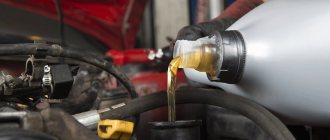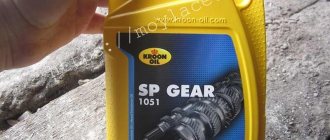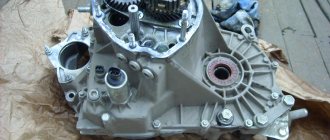As you know, today new cars are overwhelmingly equipped with automatic transmissions (automatic transmissions, CVTs or robotic transmissions). At the same time, manual transmission (manual transmission) is often installed only on budget versions of cars and some sports cars.
It is important to understand that although automatic transmissions are quite reliable, such transmissions require regular and qualified maintenance. This applies to a greater extent to automatic transmissions and CVTs, since these types of gearboxes are very demanding on the quality, condition and level of transmission oil.
In other words, the owner himself must periodically check the oil in the automatic transmission during operation. Next we will talk about what to do if the transmission fluid level is low, that is, how to add oil to the automatic transmission.
Features of automatic transmission oil
The fluid that is poured into the automatic transmission differs from the lubricant intended for manual transmissions. This is due to differences in the operating principles of the units. In “mechanics,” torque is transmitted using gears, so the oil used in such mechanisms must provide high wear resistance of the surfaces being washed. In the case of an automatic transmission, the force from the engine shaft to the transmission elements is transmitted through a hydraulic convector. A key role in this process is played by a special transmission fluid - ATF. This product is not only responsible for lubricating the surfaces that come into contact during operation of the unit, but also performs a number of other functions, including:
- direct participation in torque transmission;
- removal of excess heat from clutches and torque converter;
- removal of wear products that are formed during the operation of mechanisms.
What is the function of transmission fluid in an automatic transmission?
Let's start with the fact that many people mistakenly believe that in an automatic transmission the oil performs the same functions as in a manual transmission. In other words, the liquid lubricates loaded elements, protects parts from corrosion, washes away metal shavings and deposits, cools parts, etc.
In fact, this is not entirely true, since in such a case the same oils would be used in the manual transmission and automatic transmission. In this case, only special ATF transmission fluid must be filled into automatic transmissions.
The fact is that, in addition to the above, such a fluid is not just a lubricant and protection, but also a working element, since from the invention of the hydromechanical automatic transmission to the present day, the operating principle of such a box has not fundamentally changed.
A hydromechanical automatic transmission has a torque converter for transmitting torque from the internal combustion engine (performs the function of an automatic transmission clutch), as well as a planetary gearbox. In this case, there is no rigid connection between the engine and the gearbox.
The gas turbine engine consists of a driving pump wheel and a driven turbine wheel. Between them there is a reactor. Torque from the drive wheel to the driven wheel is transmitted through transmission fluid, which becomes very hot.
As for the gearbox, the gear ratio changes automatically (depending on the speed at which the car is moving, the load on the internal combustion engine, etc.). The gears (stages) are controlled by a planetary gear set, which is similar in principle to a manual gearbox.
In order for the necessary gears of a particular transmission to engage, friction clutches and a brake band are used. Simply put, these elements block individual elements of the planetary gear, thereby changing the gear ratio.
A valve plate (valve block) is also used to control the box. Such a plate has a large number of channels through which ATP liquid is supplied under pressure to the actuators, which allows the desired gears to be engaged in automatic mode. In modern machines, valves (solenoids) bypass fluid, which are activated by a command from the ECU.
As you can see, transmission fluid is actually a working fluid. Through transmission oil:
- all components and parts of the automatic transmission are lubricated/cooled;
- torque is transmitted in the torque converter;
- the fluid also makes it possible to change gears by squeezing the clutch packs through hydraulic pushers;
It becomes clear that not only proper operation, but also the overall resource of the unit will depend on the quality, level and condition of ATF. As a rule, manufacturers claim that modern automatic transmissions are filled with oil for the entire service life of the box, but in practice the fluid needs to be completely changed every 40-60 thousand km. mileage Also, in some cases, it may be necessary to add oil to the automatic transmission, since leaks may occur through the automatic transmission seals, seals, gaskets, radiator, etc.
How to prepare your car for measuring ATF level
The need to add oil to an automatic transmission usually arises after you have measured the fluid level in the system and found that it is below the permissible standard. In order for the results of such measurements to be reliable, certain rules must be followed when carrying them out. First of all, you need to check in the instructions what volume of gear oil is prescribed by the manufacturer for your model. Not only a lack of fluid, but also an excess amount can cause damage to the gearbox. Before you start taking measurements, you need to drive the car 5–10 km, and then place the car on a flat area. If the trip lasted more than half an hour, you should wait a few minutes for the ATF temperature to drop to the required value.
Transmission oil change interval
If you do not change the lubricant in time, it will lose its properties. This leads to overheating. And overheating, in turn, destroys rubber seals, gaskets, and clutches. Destruction of the breather leads to oil leakage. Destruction of the clutches leads to clogging of the filter device with the adhesive base.
Read
Review of the best automatic transmission additives
This is why changing the oil is so important. An untimely change will lead to repair of the automatic transmission. Although many manufacturers say that the oil on modern automatic machines does not need to be changed, do not listen to them. This is a marketing ploy. The more automatic transmissions are broken, the more money they will make by selling a new one.
So, if you just purchased a car with an automatic transmission or a CVT, then you don’t have to change the oil in the automatic transmission until you’ve driven 150,000 kilometers. Then do a full shift of working out.
After the first full change, the oil is changed at the following intervals:
- 30 thousand kilometers – partial change;
- 60 thousand kilometers - full.
If you change the lubricant at a service station, they will leave a note on the automatic transmission at which kilometer you need to change the lubricant.
Measurement procedure
To determine the transmission fluid level in an automatic transmission, you must:
- “drive” the selector through all modes (PRND) without moving. This way the oil is distributed throughout the entire unit, and the readings will be as accurate as possible;
- find the dipstick in the engine compartment, remove it and wipe it with a dry cloth;
- Insert the dipstick all the way into the hole and remove it again. The oil level is considered normal if it is between the ADD and FULL marks. If there are COLD and HOT marks on the dipstick, this does not mean that measurements can be taken on both hot and cold liquid. The COLD level is a service indicator that is used as a guide when pouring oil into an empty, unheated automatic transmission after repair or maintenance.
Oil color
Due to the fact that transmission parts rotate in the unit at high speeds, the lubricant foams. Consequently, car oil becomes unable to cope with its main task. Spare parts are not lubricated properly, they burn out, and the gearbox has to be replaced. Also, foamed oil often leaks through the breather.
It is possible to roughly assess the condition of the automatic transmission by how the transmission oil looks. If it is reddish in color, then everything is fine. If the oil is black/brown and smells like burning, then there is a problem with the unit. Small black particles floating in the lubricant indicate that the friction layer of the brake bands or other parts of the unit has been destroyed. These particles can be seen if you inspect the dipstick.
If water or coolant enters the automatic transmission, the oil fluid turns light pink. In this case, you need to carefully diagnose the automation by removing the pan.
How to add fluid
If, as a result of the check, it was determined that the ATF level is below the permissible level, you must:
- select the same oil that is poured into the transmission;
- install the machine on an inspection hole or overpass;
- move the selector to position “P”;
- turn off the engine, go under the car and unscrew the inspection hole plug;
- using a syringe with a hose or tube attached, pump in ATF until the liquid begins to pour out.
You can also add oil through the dipstick hole. The product is added until its level reaches the required level.
How to add oil to an automatic transmission
As a rule, the need to add oil to the automatic transmission is determined at the moment when the ATF level is checked. The level is checked on a fully warmed-up gearbox, while the engine must be running (in most cases, since some automatic transmissions require checking the level with the engine turned off, which can be specified separately in the manual).
To warm up the machine, you first need to drive 10 to 15 km before checking, then stop the car on a level surface. The level on most automatic transmissions is checked using a special automatic transmission dipstick.
By the way, if your car model does not have a dipstick, you need to locate the inspection hole in the area of the automatic transmission housing. Next, you will need to unscrew the control plug and assess the level visually. If it is necessary to add oil to the machine, it will also need to be filled through this hole (provided there are no other service holes).
- Before removing the probe, you must first “go through” all the machine modes (PRND), staying in each mode for 3-5 seconds. This will allow fluid to be circulated through the hydraulic system to accurately measure the level.
- Next, you can remove the dipstick, wipe it with a clean, dry, lint-free cloth, insert it back all the way and remove it again.
- Normally, the oil level in the automatic transmission should be between COLD and HOT or ADD and FULL (on a fully warmed automatic transmission, an increase above the middle is allowed, the main thing is that the level is not higher than the HOT mark).
- Please note that the presence of a COLD indicator does not mean that the level can always be checked only when cold. This mark is an approximate service indicator, that is, when oil is poured into an empty, unheated box during maintenance or repair.
If you use the COLD mark when topping up, such a measurement may cause an error, which will inevitably result in underfilling or overfilling of automatic transmission oil. The fact is that when it’s cold, the level is usually higher or lower than when it’s warmed up.
If the check shows that the oil level is low and the fluid needs to be added, then on cars without an automatic transmission dipstick, you need to do the following:
- Select in advance for topping up exactly the same automatic transmission oil that is already poured into the gearbox. This will avoid mixing transmission oils and possible undesirable consequences;
- Next, the car is driven into a viewing hole, placed on an overpass, and raised on a lift;
- Then the automatic transmission selector is set to position “P”;
- The box must be preheated, the engine is idling;
- Then you need to turn off the engine, go under the car, unscrew the inspection hole plug;
- Now, using a syringe with a tube attached, you can pump in ATF. Oil should be added until the liquid begins to flow out through the edge of the inspection hole;
- After ATP begins to flow out, the control hole plug can be tightened;
We also recommend reading the article about what oil to select for an automatic transmission, how to select oil for an automatic transmission by make, model or VIN code. - On models with a dipstick, automatic transmission fluid is poured through the dipstick neck. The dipstick is removed, then a funnel for automatic transmission oil is inserted into the neck. If there is no funnel, use a clean flexible hose;
- You can also attach any suitable funnel to the other end of the hose. You need to fill in ATF a little at a time and wait a short pause so that the oil has time to spread throughout the system. Next, you need to sit in the cabin, press the brake and turn on all automatic modes;
- After this, the dipstick is inserted and the level is checked. The procedure is repeated if necessary until the level is optimal;
Separately, we would like to add that if the oil level in the automatic transmission is higher than normal, this will also negatively affect the operation and condition of the automatic transmission. The fact is that if it is exceeded, the liquid tends to foam. As a result, the lubrication properties deteriorate significantly, the pressure in the system decreases due to the formation of air pockets, etc.
In case of overflow, the box operates with shocks or jerks, clutches burn out, and other transmission parts wear out. Also, excess oil can be squeezed out through the breather, which leads to oiling of the housing.
How to change the oil in a manual transmission and flush the manual transmission when replacing
Draining oil in manual transmission
First you need to drain the old fluid through the drain plug. Next, flushing oil is poured through the manual transmission filler plug using special blowers or syringes. After this, you need to start the car and let the engine run for a while, changing gears without putting too much load on it. This is necessary so that all moving parts are washed. Typically, the purchased flushing oil comes with detailed instructions for its use.
Next, you need to drain the flushing oil, paying attention to whether scale, pieces of metal, or shavings fall out. If this is observed, then this indicates a lot of wear on the gearbox parts.
In this case, you need to seek diagnostics. It is especially worth paying attention to the drain plug; in particularly difficult cases, it can be covered with metal shavings (if the plug is equipped with a magnet). This indicates that there has been a lot of wear and tear on the inside of the box. If the flushing fluid looks normal, then there is no cause for concern. You also need to check for leaks at the joints of the crankcase halves, the gearbox housing, and at the shanks where the seals are installed. If there are no problems with this, then you can fill in new oil in accordance with the manufacturer’s recommendations and the season.
Recommendations from experts
How to add oil to an automatic transmission? After determining the amount of lubricant and detecting the need for refilling, make sure that the selector is in the “P” position and the engine is idling. It is advisable to install the car on the handbrake to avoid troubles.
The operating manual that comes with your vehicle should indicate what brand of lubricant should be poured into the car and in what volume. Often the oil name is on the dipstick.
The manual also indicates how often the consumable should be replaced. Typically, the ATF change interval is one hundred to two hundred thousand kilometers. In reality, the frequency of replacement varies and depends on operating conditions and road quality. Is it possible to change the oil fluid more often than required? If you change your car oil earlier than necessary, nothing bad will happen.
Adding oil to the box is quite simple. Place a funnel in the neck where the dipstick was (it is better to use a long funnel, it will be more stable). Carefully pour the required volume of petroleum product into it. It is recommended to pour lubricant in portions to avoid overfilling. Before you start topping up, be sure to find out which oil is optimal for your car.
First, pour 1 liter of motor oil. Then lower the dipstick into the hole, if necessary, add 0.5 liters of consumables. Repeat the procedure until the amount of lubricant is optimal.
If you decide to completely change the car oil and wash the automatic transmission, then you will need at least four to five liters of transmission lubricant. After finishing filling, put the dipstick back. There are brands of cars in which the dipstick needs to be fixed until it clicks or turned to secure it. Then you need to start the engine and move the selector through all modes.
Follow the car manufacturer's advice when selecting transmission oil. There is no need to mix consumables from different manufacturers. If you ignore the recommendations, you may soon need to spend money on expensive repair work. If you are not confident in your abilities or you are simply too lazy to do this, contact the car service staff. They will add lubricant to the unit, diagnose your car, and identify faults that exist in the vehicle.
Today, most cars are produced with automatic transmissions and CVTs. Only budget brands of cars are equipped with mechanics. Automation has become quite reliable, although it requires some simple maintenance. For example, motorists should know how to add oil to an automatic transmission if for some reason there is a transmission fluid leak. To understand how the automatic machine works and what role the transmission oil plays in this, you should get acquainted with the device itself.
Tips and tricks
As you can see, when choosing transmission oil, it is important to avoid mistakes if you plan to change the oil in a manual transmission.
First of all, you should study the manual, based on the recommendations indicated by the vehicle manufacturer. It is recommended to select a lubricant taking into account the oil base and viscosity. You also need to make allowances for the temperatures at which the car will be used, what loads the transmission experiences, etc.
It would also be a good idea to seek help from specialists at service stations, since the fuel and lubricants market is developing, manufacturers of oils for engines and gearboxes are constantly offering new solutions, improved oils, and using modified additive packages.
Regarding the question of how often you need to change the oil in a manual transmission, and also what to consider when changing it, on average, it is recommended to change the lubricant in a manual transmission every 60 thousand km. You should also remember that when changing the oil in a manual transmission, it is not possible to completely drain the oil.
This means that old and new oil are mixed, that is, you need to pay attention to the compatibility of the products
For example, mixing a mineral base with a synthetic one is strongly discouraged; negative consequences are possible after mixing “mineral water” and semi-synthetics, etc.
If the owner switches from one type of oil to another, attention should be paid to this when selecting a lubricant for the gearbox
A few words about the importance of checking the oil in the gearbox
It was already mentioned earlier that the automatic transmission device is a rather complex mechanism. For information, it consists not only of a planetary gear set that changes gears, but also a torque converter, transmitting torsion of the shafts and an electronic control unit. With the exception of the last element, all components of the gearbox perform enormous mechanical work, which is associated with constant transmission and control of rotation, which is simply impossible without friction of the parts. All the side effects of friction can be eliminated precisely by using transmission oil, which constantly circulates through the cavities of the automatic transmission and lubricates the working mechanisms.
This automatic transmission fluid plays an important role. In addition to increasing the service life of rubbing elements, oil helps:
- Avoid frequent overheating of the box;
- Partially clean the insides of the automatic transmission from dirt;
- Stable operation of its components.
The main rule for using an automatic transmission sounds extremely simple - the more often and with better quality the oil in the automatic transmission is changed, the longer the mechanism will serve for the benefit of its owner. As practice shows, such a saying is not a simple formality, but a real state of affairs.
Typically, automatic transmission oil undergoes two main operations:
- A check consisting of assessing the condition of the fluid, its quantity and oil pressure in the automatic transmission;
- Partial or complete oil change, the need for which is determined based on the results of the above procedure.
We will cover each operation in more detail below. Now let’s sum up the logical conclusion of this paragraph of the article and state that checking the oil level in the automatic transmission and its timely replacement are simply unacceptable to be ignored, if only because they can significantly extend the service life of the gearbox.
What volume should be in the checkpoint
Cars of different brands and models differ in their design, and accordingly there are differences in the structure of the boxes. Different models of different cars use different amounts of oil. Find a clear answer to the question “how much oil should be in the box?” You can only read the manual or operating instructions for the car, or find out this at a service station. When replacing, it is worth remembering that there are differences in their compositions and types. You should always buy with a small reserve (0.5 - 1 liter) so that you can top up if there is a leak during replacement.
There are three types for gearbox:
- synthetic;
- semi-synthetic;
- mineral.
Synthetic
It is considered the most modern, it is well cleaned and enriched with additives that maximally protect mechanisms from corrosion. It is mainly poured into automatic transmissions or manual transmissions of high-end cars. In automatic transmissions it should be changed every 50 thousand km. mileage In mechanical ones - every 60-70 thousand km. mileage In terms of cost, this type is the most expensive, but also the best. But this does not mean that it can be poured into the boxes of old cars: they may simply not be designed for this!
Semi-synthetic
Semi-synthetic is used in most budget foreign cars, in the entire range of the 10th AVTOVAZ family (Lada Kalina, Priora). It contains a number of chemical additives that protect gears, synchronizers and other mechanical parts from wear. It is worth replacing such oil every 40-50 thousand km. mileage The biggest plus is the price-quality ratio.
Mineral
The mineral is used in axles and gearboxes of rear-wheel drive vehicles. For example, in the entire line of AVTOVAZ classics or similar cars, as well as in some trucks. The mineral one is purified less than all the others; accordingly, it degrades faster and requires replacement quite often - every 35-40 thousand km. mileage
Useful tips
How to add oil fluid if the measurement shows a low level? If the car does not have a dipstick, but only has a control hole, it must be installed above an inspection hole or driven onto an overpass. Topping up is preceded by the following actions:
- set the automatic transmission selector to “P”; do not turn off the engine, let it run at idle; To be sure, tighten the handbrake again.
With a dipstick, things are simpler. The oil liquid is poured through the neck, which serves as a seat for the dipstick. A hose is inserted, at the other end of which there is a funnel. Fill with ATF in small portions until the dipstick shows a normal level. The engine is running all this time. After this, sequentially, with the brake pressed, switch the automatic transmission selector several times and then measure the fluid level again.
Replacement features
How long does it take to change the oil in manual and automatic transmissions?
Now we proceed directly to the procedure for changing the transmission oil. The task is not difficult, but it is not worth approaching this issue lightly.
- Always have a dry cloth ready to wipe the dipstick when removing it from the boat;
- Before checking the lubricant level, warm up the car and change 1-2 gears;
- It is necessary to check the lubricant level before and after replacement;
- If your VAZ 2109 is not equipped with a dipstick, use the lower edge of the oil filler hole as a guide. The liquid should reach this edge, but not be higher or lower than this mark.
For a gearbox, under-lubrication is just as bad as over-lubrication. Always try to find a middle ground so that the gearbox can operate as efficiently, long and reliably as possible.
Which oil is best for manual transmission?
Using a certain brand of oil saves car owners from the need for major repairs or replacement of a manual transmission. In terms of technical characteristics and purpose, transmission fluids are very similar to motor oils. A natural question arises: is it possible or necessary to pour a lubricant intended for power units into the gearbox.
Experienced auto mechanics and official representatives of manufacturing plants have not yet given definite answers. However, they do not deny that in emergency situations you can pour motor oil into the manual transmission gearbox. Especially if the car is equipped with front-wheel drive (transmission of the torque of the power unit to the front axle). This is due to the unique cylindrical gear design in manual transmissions of front-wheel drive vehicles.
Separation of oils for manual transmissions by viscosity degree
The main difference between gearbox lubricants and motor lubricants is the oil viscosity indicator. Even visually they can be distinguished by their thickness: lubricant for engines is more liquid and fluid. The degree of viscosity of transmission substances is much higher than their motor counterparts. Before filling a manual transmission with oil produced for internal combustion engines, it is recommended to check how acceptable such an alternative is and how this will affect the technical characteristics of the vehicle as a whole. Motor oils are more affordable in price, however, if you pour incorrectly selected engine oil into the box, the likelihood of irreversible processes increases. Repairing a damaged gearbox will be very expensive for the owner.
Gear oils are classified according to different classification methods. Viscosity division is carried out into classes according to the international SAE system. The SAE rating measures how thick or thin each substance is. Transmission oils are available in winter, summer and all-season varieties.
Depending on the loads on the gears, oils are divided into standards Gl 4 and Gl 5. The most common option for manual transmissions of cars, buses, etc. are lubricants of the Gl 4 group. These formulations are designed for vehicle operation under heavy loads and high speeds. Unlike Gl 4, oils of the Gl 5 group are more suitable for axle gears.
Box without dipstick
Controlling the amount of liquid using a dipstick is quite simple. Every car owner can handle this procedure. But how to check the oil in an automatic transmission if the factory dipstick is missing?
If an automatic transmission does not have a dipstick, this often means that there is no need to change the transmission fluid during the entire life of the car. Or the automaker thus limits independent maintenance of the transmission system, transferring this function to service centers that have the appropriate certificates.
Automatic transmissions without a dipstick have 2 openings - oil filler and oil drain. There cannot be an excess amount of oil in an automatic transmission of this type, since it is equipped with a tube through which the excess goes into the pan during operation of the vehicle. But monitoring the decrease in emulsion levels is not so easy. If you doubt that you can do this yourself correctly, contact a specialist.
Let's look in more detail at how to check the oil in an automatic transmission:
- Drive the vehicle a few kilometers to bring the transmission up to operating temperature.
- Place the car in a hole so that you can examine its bottom. Leave the engine running and switch to Parking mode.
- Locate the drain hole on the bottom of the car near the engine location and unscrew its plug. If there is enough emulsion, it will flow out of the opening slightly. If there are not even a couple of drops, then its level is unacceptably low.
- If there is too little transmission fluid, add it through the oil filler hole with the engine running. When oil begins to flow out of the drain hole, this will be a signal that you have filled it enough.
When determining the emulsion level, pay attention to how it looks. If there are particles of slag or impurities in it, then it’s time to change the oil. Every driver should know how to check the oil in an automatic transmission with their own hands
If you master this skill, you will not have to regularly go to a car service for such a procedure. This will greatly help you save additional money.
Every driver should know how to check the oil in an automatic transmission with their own hands. If you master this skill, you will not have to regularly go to a car service for such a procedure. This will greatly help you save additional money.
What happens if there is too much oil or not enough?
Each automatic transmission configuration has its pros and cons. This explains why changing the amount of transmission fluid affects the assembly.
Tips for choosing transmission fluid
Many automatic transmission owners quite reasonably ask questions about what kind of oil to pour into their automatic transmission, and how big the differences are between different transmission fluids. In fact, they pour whatever they want into them, without even thinking about the consequences. It is not worth highlighting specific fluid manufacturers, because for automatic transmission oil it is much more important that it meets the world standard ATF WS (ATF WS).
For information, ATF WS (from English - Automatic Transmission Fluids World Standard) is a standard for the production of transmission fluids, designed more than 80 years ago. All oils produced in accordance with ATF WS are a suitable product that will serve as long and efficiently as possible. We can definitely say that any transmission fluid marked “ATF WS” is worthy of purchase and will be exceptionally good in operation.
However, for some types of automatic transmissions there are also their own transmission oil standards. Thus, in Europe, liquids labeled “ZF TE-ML” and “FNM” are widespread. In any case, you should choose ATF WS or any other oil based on the recommendations of the automatic transmission manufacturer, who checked all transmission oils and chose the most successful option for the constant operation of their unit. We hope that now the question of what oil to pour into an automatic transmission will not cause you any difficulties.
Perhaps the most important information on today's topic has come to an end. We wish all readers of our resource good luck in repairing and operating their cars!
If you have any questions, leave them in the comments below the article. We or our visitors will be happy to answer them
Types of transmission oils
It is necessary to add oil of the same brand as was
To ensure that the transmission system does not lose its operating properties, a car with an automatic transmission should be filled with oil of the appropriate class. As a rule, ATF fluid is used for this type of transmission. It is possible to purchase synthetic, semi-synthetic, and mineral oils. Car owners have a demand for the first of these types of transmission fluids.
Advantages of synthetic oils:
- Ensuring high-quality lubrication of rubbing parts.
- Optimal viscosity.
- Resistant to sub-zero temperatures.
Mineral oils, when compared to synthetic ones, have poor performance characteristics. Semi-synthetic ones provide an antioxidant effect and do not lose their properties when used at low temperatures. Thanks to the properties of synthetic oils, long-term operation of gearboxes is ensured.
For each specific version of the car, the transmission fuel replacement interval is individual. However, in most cases, automatic transmission fluid replacement is necessary at 60,000 km. Every 15,000 km the oil level should be checked. Premature replacement may be due to the fact that the driver systematically violated the basic rules for operating a car, towing, etc.
Thus, when choosing transmission fuel, the car owner should strictly follow the manufacturer’s recommendations and purchase a fluid that provides excellent lubricating properties.
For most modern cars, GL-4 (5) class oils are suitable. It’s worth figuring out how to add oil to an automatic transmission and checking its quantity in the box.
History of appearance and operating principle of automatic transmission
Automatic transmission is one of the main components of the transmission of a modern car. The main task of this unit is to create balance between the running engine and the spinning wheels. This work is carried out by finely selecting the gear ratio for each mode of engine operation. The main difference between an automatic transmission and a manual transmission is its fully automatic operation, which does not require driver intervention.
The first prototype of an automatic transmission appeared at the Henry Ford plant in the 20s of the last century. It was different from modern units, but the rudiments of modern machines were already present in them. More advanced units began to be produced after one decade -. They were operated on the principle of a servo drive, which is a mechanical gearbox with automatic state correction through negative feedback.
At the end of the 30s, the Chrysler organization introduced an innovative development that included a fluid coupling and a torque converter. This machine was a breakthrough in the automotive industry.
A more or less similar automatic transmission was developed in the early 50s by American engineers. It consisted of 3 parts:
- electronic;
- hydraulic;
- mechanical.
The development began to be actively used only in the 80s, during the period of rapid progress in microprocessor technologies.
The operating principle of the machine comes down to automating gear shifting. Before we consider in detail the structure and operating features of automatic transmissions, it is worth highlighting their varieties:
- variable speed drive;
- robotic gearbox;
- An automatic transmission equipped with a torque converter is considered a standard automatic transmission.
The design works thanks to the close interaction of electronics, mechanical parts and hydraulics. These elements are represented by the following details:
A torque converter that receives torque from the engine and transmits it to the shaft.
- A gearbox that receives force from a torque converter and drives the wheels through a gearbox.
- Control devices that regulate the head control of the unit and are responsible for the mechanics of the box.
The role of the driver in an automatic transmission is assigned to the control devices. Since an automatic transmission is more complex than a manual transmission, the oil for it is selected more carefully.











